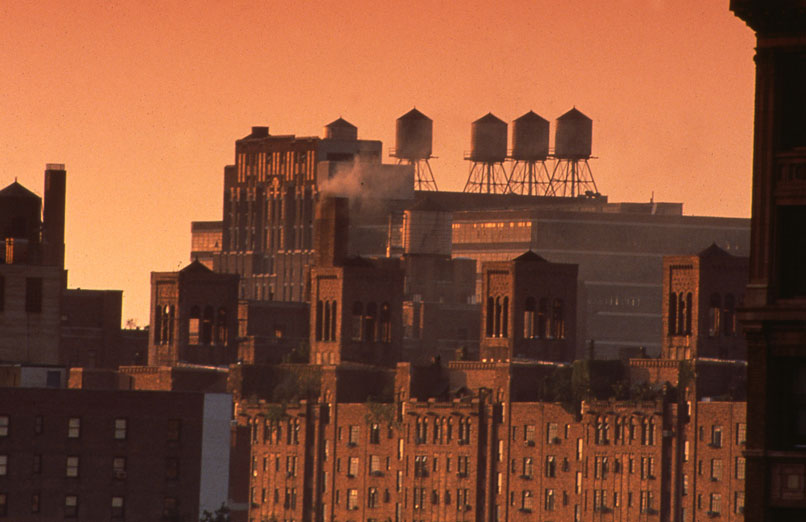We live in New York City and what we cash in for culture and diversity, we cash out for natural beauty. So when it comes to dramatic, awe-inspiring vistas, we’ll take what we can get.
Plastic bags caught in tree branches, steam billowing up from Con Ed’s ubiquitous orange vertical vents, and broken fire hydrants gushing streams of water. If initially off-putting, these images often become the familiar and beloved objects in our urban landscape, but nothing figures more prominently in this cityscape than the visual of the weatherworn rooftop water tower.

Water tanks still serve a function
Like many of the fixtures within New York City’s infrastructure, many of us see water tanks dotting rooftops, but have little idea of their specific uses and upkeep. Although they often look defunct, water tanks are still an essential part of the city’s day-to-day needs. These tanks are responsible for providing drinking and bathing water to residential buildings across the city and are a major piece of our city’s sanitation efforts.
In fact there are between 10,000 and 15,000 functioning water tanks throughout the city, each of which is located on a residential building of six stories or more. In the early 20th century, as the city’s population expanded and building engineering improved, apartment buildings grew in height and number, thereby necessitating the use of rooftop water tanks. Although building heights and population stats have continued to grow over the years, the use of rooftop water tanks is still the most efficient and practical way to provide water to residents.
Each of these tanks is hooked up to a water pipe in the building, and, similar to a toilet, when water in the tank does down, a device signals the water level is low. Then, like magic, an electric pump kicks in, pushing water up to refill the tank.
Rosenwach water tanks ingrained in local lore
While the prevalence of rooftop water towers remains strong, the number of water tank manufacturers has dwindled to just two – Rosenwach Tanks and Isseks Brothers.
Founded almost 150 years ago, Rosenwach Tanks is perhaps the better known of the two and continues a robust business, responsible for the production and upkeep of hundreds of rooftop tanks across the city each year. Their tanks hold a special place in local lore and for many avid and nostalgic New Yorkers, they represent both a niche product and totemic emblem singular to NYC living.

Perks of a wooden water tank
Rosenwach fans need not fear the extinction of water tanks because the company’s survival is part and parcel with the efficiency and practicality of the product. Although steel water tanks are also an option, the wood tanks Rosenwach produces, which are made from Western cedar, are not only easier and faster to make, but they are far cheaper, weigh less and are far better at moderating water temperature than their steel counterpart. That means water does not freeze in the winter and stays relatively cool in the summer thanks to the temperature moderation powers of wood. A wooden tank lasts up to 30 years and requires minimal maintenance.
How clean are water tanks?
Though upkeep is limited to annual removal of the sediment that builds up at the bottom of tank, it’s not something to be lax about. If left unattended, the water within the tanks can stagnate and become a breeding ground for bacteria and E. coli.
Yep, all those strident claims to New York’s tap water being on par with the finest European bottled water go down the tubes when you consider that it’s actually the water fresh out of the upstate NY reservoirs and treatment plants that make it so pure, not the water that’s been sitting in a unattended, rusted-out tank all summer. That said it is up to a building’s landlord to oversee regular cleaning, upkeep and maintenance of his building’s water tank. If done regularly, the water in the tank should have no sediment build up and be perfectly fine for drinking and bathing.
Beyond water
To this day, the primary purpose of the water tank remains providing water to residents, but they’ve certainly inspired some creative alternative uses. Last summer, the Water Tank Project gathered local artists, students and even some big name artists including, Jeff Koons, Ed Ruscha, Maya Lin, John Baldessari, Carrie Mae Weems among others all in effort to redress the tanks.
The work of individual artists or teams of collaborators was wraparound the tanks. The aim was to celebrate the talent and creativity of the artists and also to draw attention to these unique structures and the essential resource they provide. Other adaptations of the water tank have included, in a typical New York fashion, converting the interior of the tank into an exclusive, speakeasy style cocktail lounge. This city never seems to cease to produce nor tire of its good art and good bars. It’s fitting then that the water tank has come to house both.
Related:










